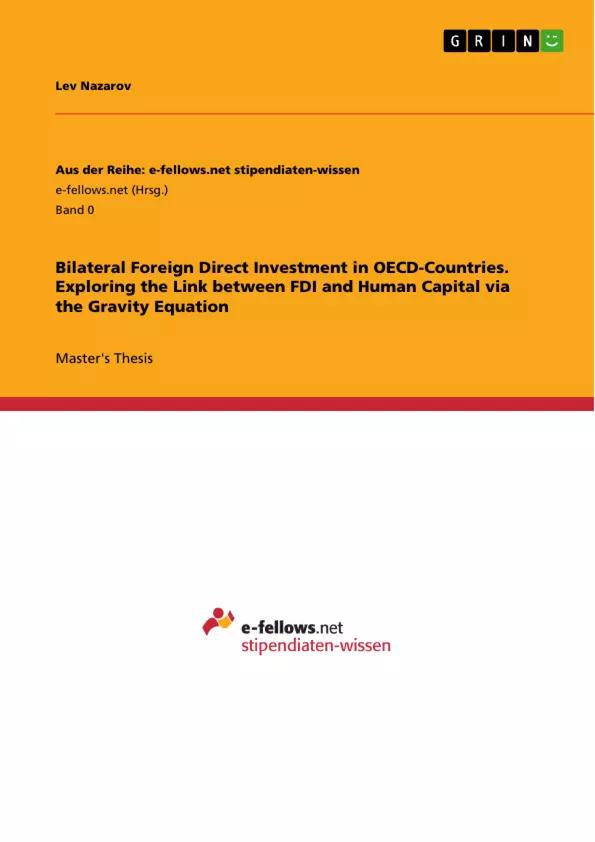The thesis at hand examines whether human capital endowment has significant explanatory power on foreign direct investments in OECD countries between 1985 and 2017. The author has applied quantitative as well as qualitative human capital variables in the spirit of the bilateral gravity approach, while applying a version of the gravity model which accounted for country- and year-fixed-effects. The persistence of the results has been analysed via subsamples of the periods 1985 to 2000 and 2001 to 2017. Additionally, both, FDI stock and flow data have been used to test whether the empirical findings are robust regarding the respective data choice.
In the past decades research produced plenty of papers, monographies and books regarding the analyses of the determinants of international financial capital flows (FDI). This strand of scientific literature is closely related to the activities of multinational companies/enterprises (MNCs/MNEs).
Inhaltsverzeichnis (Table of Contents)
- 1. Introduction
- 2. Definitions and theoretical Models of FDI
- 2.1 Early Theories and Models of FDI
- 2.2 FDI in the Spirit of the traditional International Trade Theory
- 2.3 FDI in the spirit of the Eclectic-Approach
- 2.3.1 The OLI Paradigm
- 2.3.2 Criticism and modern Relevance of the OLI Paradigm
- 2.4 FDI in the Spirit of the Gravity Approach
- 2.4.1 Motives for the Application of the Gravity Approach and early Shortcomings
- 2.4.2 Modern Gravity and Trade in Goods
- 2.4.3 From trade to FDI and the Proximity-Concentration Hypothesis
- 2.5 Summary and concluding Remarks
- 3. State and Strands of empirical FDI Literature
- 3.1 General Findings within empirical FDI Literature
- 3.2 Empirical Findings on the Relationship between FDI and HC
- 3.2.1 The empirical Relationship between FDI and HC before 2003
- 3.2.2 The empirical Relationship between FDI and HC since 2003
- 3.3 Interim Conclusion relating empirical Findings on FDI and HC
- 4. Motivation, Data and Model Specification
- 4.1 Conception and Interpretation of the FDI Data
- 4.2 Examination of the applied FDI Datasets
- 4.3 Measuring Human Capital
- 4.3.1 Key Concepts and Problems of Human Capital Measurement
- 4.3.2 Human Capital Measures applied
- 4.4 Control Variables and Data Sources
- 4.5 Econometric Approach and Model Specification
- 4.6 Hypotheses and expected Results
- 5. Empirical Analysis of the FDI Datasets
- 5.1 Descriptive Analysis of the independent and dependent Variables
- 5.2 Correlation Analysis of the Regression Variables
- 5.3 Discussion of empirical Results
- 5.3.1 Regression Results for FDI Flow Data
- 5.3.2 Regression Results for FDI Stock Data
- 5.4 Robustness Checks of the empirical Results
- 6. Summary of empirical Results and Policy Implications
- 7. Conclusion and Future Research
Zielsetzung und Themenschwerpunkte (Objectives and Key Themes)
This thesis aims to investigate the explanatory power of human capital on foreign direct investment (FDI) in OECD countries between 1985 and 2017. By utilizing both quantitative and qualitative human capital variables within the framework of the bilateral gravity approach, the study aims to shed light on the relationship between FDI and human capital. The analysis also incorporates country- and year-fixed effects and examines the robustness of the findings through sub-samples of 1985-2000 and 2001-2017.
- Examining the impact of human capital on FDI in OECD countries
- Exploring the relationship between FDI and human capital using quantitative and qualitative measures
- Analyzing the robustness of the findings through sub-sample periods and data choices
- Applying the bilateral gravity model with country- and year-fixed effects
- Contributing to the ongoing debate on the relationship between FDI and human capital
Zusammenfassung der Kapitel (Chapter Summaries)
- Chapter 1: This chapter provides an introduction to the thesis, outlining its objectives, research questions, and the structure of the following chapters.
- Chapter 2: This chapter delves into the theoretical framework of FDI, reviewing key theories and models, including the early theories, traditional international trade theory, the eclectic approach, and the gravity approach. It also highlights the OLI paradigm and its relevance in the context of FDI.
- Chapter 3: This chapter examines the state of empirical FDI literature, providing a comprehensive overview of general findings and specifically focusing on the relationship between FDI and human capital. It discusses existing empirical studies and their findings, highlighting both earlier and more recent research.
- Chapter 4: This chapter elaborates on the motivation, data, and model specification used in the study. It discusses the conception and interpretation of FDI data, examines the datasets used, explores different approaches to measuring human capital, and details the econometric approach and model specification employed in the analysis.
- Chapter 5: This chapter presents the empirical analysis of the FDI datasets, including descriptive analysis of variables, correlation analysis, and regression results for both FDI flow and stock data. It also explores robustness checks of the empirical findings.
- Chapter 6: This chapter summarizes the empirical results and discusses their policy implications, highlighting key findings and their relevance for policymakers.
Schlüsselwörter (Keywords)
This study explores the relationship between foreign direct investment (FDI) and human capital in OECD countries using a gravity model approach. It investigates the explanatory power of different human capital measures, including both quantitative and qualitative variables, and examines the robustness of the findings across different time periods and data choices. The study contributes to the ongoing debate on the significance of human capital for attracting FDI. Key terms and concepts include: foreign direct investment, human capital, gravity model, OECD countries, bilateral investment flows, econometrics, fixed effects, robustness analysis.
- Citation du texte
- Lev Nazarov (Auteur), 2019, Bilateral Foreign Direct Investment in OECD-Countries. Exploring the Link between FDI and Human Capital via the Gravity Equation, Munich, GRIN Verlag, https://www.grin.com/document/1337515



